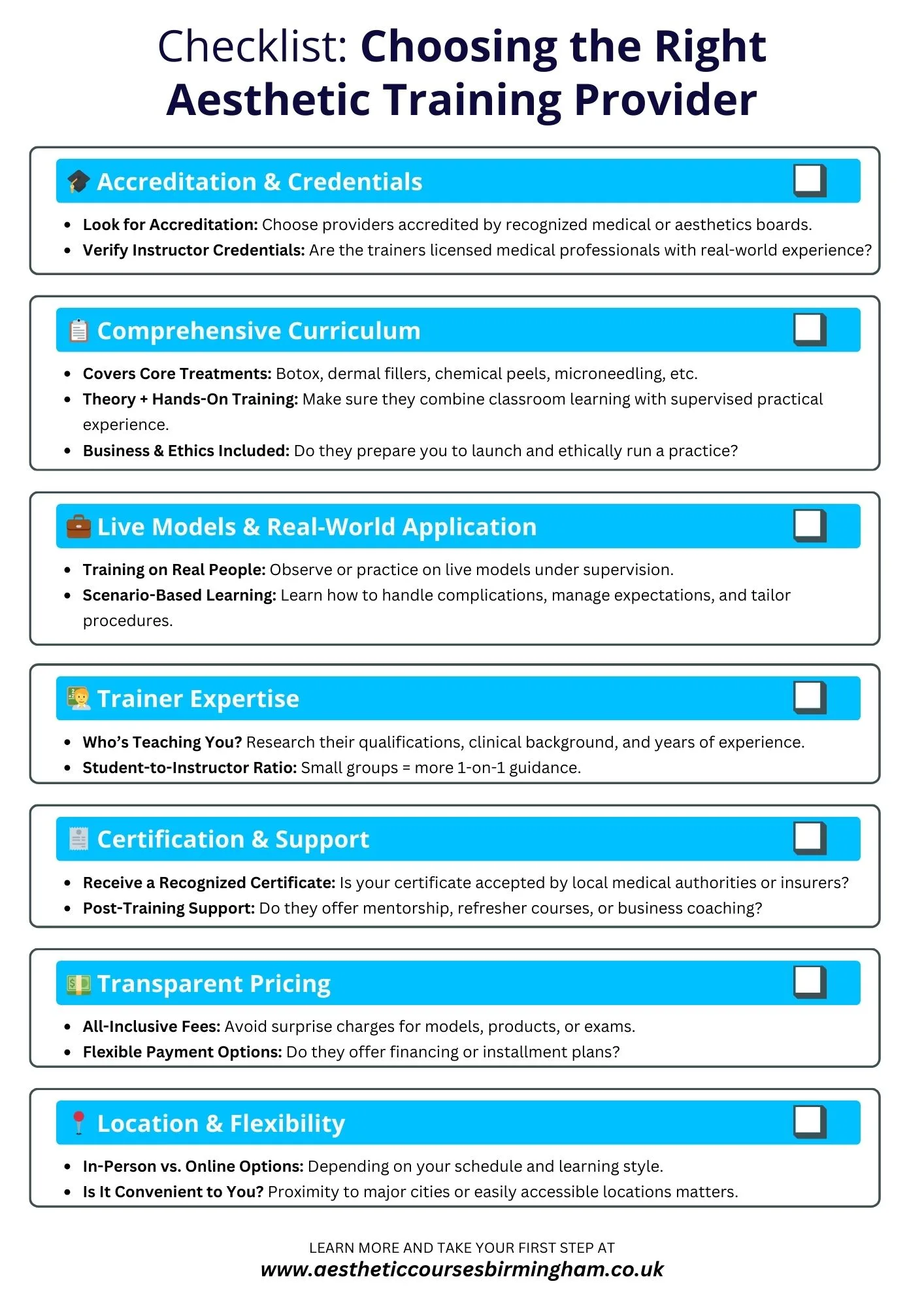
Ever watched someone transform a face with a tiny touch of filler or a subtle skin treatment—and thought, I’d love to do that? Good news: you don’t need to be a doctor to become part of the thriving aesthetics industry.
A new wave of aesthetic training courses is breaking down the barriers, giving non-medics the skills, confidence, and certification to offer sought-after treatments like dermal fillers, skin rejuvenation, and more. This isn’t about chasing trends. It’s about building a career in a fast-growing industry that blends creativity, precision, and the power to help people feel amazing in their own skin.
Wondering how you can get started (and actually succeed)? Keep reading—you might just discover your new career.
Key Takeaways
-
Aesthetic training is crucial for non-medics to ensure safe practise in beauty treatments.
-
Various courses cater to different skill levels, from beginners to advanced practitioners.
-
Accredited programmes, like QUALIFI, offer recognised qualifications in aesthetic practise.
-
Online learning options provide flexibility for those balancing work and study.
-
The demand for skilled aesthetic practitioners continues to grow, creating numerous career opportunities.
Understanding Aesthetic Training For Non Medics
The Importance Of Aesthetic Training
So, you’re thinking about getting into aesthetics but don’t have a medical background? That’s totally doable! Aesthetic training is super important, regardless of your background. It’s not just about learning how to inject filler; it’s about understanding the science behind it, client safety, and ethical practise.
Proper training ensures you’re not just following trends but providing safe and effective treatments. Without it, you’re basically driving a car without knowing the rules of the road – risky for everyone involved.
Benefits Of Non Medic Aesthetic Courses
Non-medic aesthetic courses open up a whole new career path. You get to learn cool skills, work in a growing industry, and help people feel better about themselves. Plus:
-
Flexible career options: Work in a clinic, start your own business, or even offer mobile services.
-
High earning potential: The demand for aesthetic treatments is rising, meaning more opportunities to earn.
-
Personal satisfaction: Making a positive impact on clients’ confidence is a great feeling.
These courses are specifically designed to give you the knowledge and practical skills you need, without requiring years of medical school. It’s a fast track into a rewarding career.
Career Opportunities In Aesthetics
So, where can aesthetic training actually take you? Loads of places! You could be:
-
An aesthetician in a clinic, performing treatments like laser hair removal or skin rejuvenation.
-
A freelance practitioner, offering services to clients in their homes.
-
A business owner, running your own aesthetic clinic.
And it’s not just about the treatments themselves. There are opportunities in sales, training, and even product development. The aesthetic industry is booming, and it needs skilled people like you. It’s a pretty exciting time to get involved, to be honest.
Types Of Aesthetic Training Courses Available
One of the first things you’ll realise is just how many different courses there are. It can feel a bit overwhelming, but breaking it down makes it easier. Basically, courses range from beginner-friendly introductions to seriously advanced stuff.
Let’s have a look at different courses types:
Foundation Courses For Beginners
If you’re completely new to aesthetics, a foundation course is where you want to be. They’ll give you the basics in things like skin anatomy, hygiene, and client consultation. You’ll probably get to try your hand at some simple treatments too, like basic facials or microdermabrasion. It’s a good way to see if aesthetics is really for you without committing to something super intense right away.
Advanced Aesthetic Practise Courses
Once you’ve got the basics down, you might want to move on to something more advanced. These courses are for people who already have some experience and want to learn more complex procedures.
We’re talking things like chemical peels, advanced micro-needling, and maybe even some injectables (depending on your background and local regulations, of course). These courses usually require you to have completed a foundation course first, and they’ll often involve a lot more hands-on practise. It’s where you really start to hone your skills and build your confidence.
Specialised Training In Aesthetic Procedures
Then there are the super-specific courses. These are focused on teaching you one particular treatment or technique in detail. For example, you might take a course just on Botox injections, or one specifically on laser hair removal.
These courses are great if you want to become an expert in a certain area, or if you need to add a specific treatment to your existing skillset. They tend to be shorter and more intensive than the foundation or advanced courses, and they’ll usually assume you already have a good understanding of the basics.
Choosing the right course really depends on where you’re starting from and where you want to go. Do your research, talk to different training providers, and don’t be afraid to ask questions. It’s an investment in your future, so you want to make sure you get it right.
Accredited Aesthetic Training Programmes
It’s not just about knowing how to inject filler; it’s about understanding the science behind it and having the credentials to back up your skills. Let’s have a look at some of the accredited programmes out there.
QUALIFI Level 4 Aesthetic Practise
QUALIFI Level 4 Aesthetic Practise is often seen as a great starting point. It gives you a solid foundation in the basics. You’ll learn about things like skin anatomy, health and safety, and client consultation. It’s like building the base of a house – you can’t put the roof on without it! This level is perfect if you’re new to the aesthetics world and want to get a recognised qualification under your belt.
QUALIFI Level 5 Aesthetic Practise
Ready to step things up a notch? QUALIFI Level 5 Aesthetic Practise is where you start getting into more advanced techniques. Think things like advanced skin assessment and more complex procedures. It’s designed for those who already have some experience and want to expand their skillset. It’s a bit like going from driving a regular car to driving a sports car – you need to know the basics first, then you can learn how to handle the extra power!
QUALIFI Level 7 Aesthetic Practise
This is the big one! QUALIFI Level 7 Aesthetic Practise is the highest level of qualification in aesthetics, and it’s aimed at experienced practitioners who want to become experts in their field. You’ll be learning about things like managing complications, advanced injection techniques, and even research.
Think of it as becoming a specialist consultant in aesthetics. It’s a serious commitment, but it can really set you apart from the crowd. It’s not easy, but it’s definitely worth it if you’re serious about a career in aesthetics.
Online Learning Options In Aesthetic Training
Flexibility Of Online Courses
Online aesthetic training courses? They’re a game-changer, honestly. The main thing is the flexibility – you can fit the learning around your life, not the other way around. Got kids? Work full-time? No problem. Evening, weekends, lunch breaks – it’s all doable. Plus, you can revisit the material as many times as you need.
Accredited Online Aesthetic Programmes
Before you enroll in, make sure to choose an accredited course. I mean, you want a qualification that’s actually worth something, right? Look for programmes that are recognised by reputable aesthetic bodies.
Accreditation means the course content is up to scratch, the trainers know their stuff, and you’ll actually learn what you need to know to practise safely and effectively.
Essential Skills Acquired Through Aesthetic Training
What exactly will you learn? It’s not just about knowing how to inject filler; it’s a whole package of skills that’ll set you up for success. Let’s break down some of the key areas you’ll be focusing on during your training.
Client Consultation Techniques
Alright, first up: talking to clients. Sounds simple, right? But it’s way more than just asking what they want. It’s about understanding their needs, managing their expectations, and making sure they’re a good fit for the treatment.
You’ll learn how to:
-
Ask the right questions to uncover their goals.
-
Assess their skin and facial structure.
-
Explain procedures clearly and honestly.
-
Handle tricky situations, like unrealistic expectations.
-
Build trust and rapport, so clients feel comfortable and confident.
Anatomy And Physiology Knowledge
Okay, this is where things get a bit science-y, but trust me, it’s super important. You can’t go poking around with needles without knowing what’s underneath the skin.
You’ll be studying:
-
The structure of the skin, muscles, and bones in the face.
-
How different tissues react to treatments.
-
Potential risks and complications.
-
Emergency procedures, just in case.
Practical Skills For Aesthetic Procedures
This is the hands-on part everyone’s excited about! You’ll be learning the actual techniques for different aesthetic procedures. This includes:
-
Injection techniques for fillers and anti-wrinkle injections.
-
How to use different types of equipment, like lasers and micro-needling devices.
-
Proper hygiene and safety protocols.
-
How to handle complications and emergencies.
-
Lots and lots of practise on models (under supervision, of course!).
Choosing The Right Aesthetic Training Provider

With so many courses out there, how do you pick the right one? It can feel a bit overwhelming, but don’t worry, we’ll break it down.
Factors To Consider When Selecting A Course
Okay, first things first, what do you want to get out of this? Are you a complete beginner? Or do you have some experience and want to level up? Think about the specific procedures you’re interested in.
Not all courses are created equal, and some might specialise in certain areas. Also, consider the course format. Do you learn best in a classroom, or would you prefer the flexibility of online learning?
Here’s a quick checklist:
-
Your current skill level
-
Your career goals
-
Course content and specialisations
-
Learning style and preferred format (in-person, online, hybrid)
-
Budget (courses can vary wildly in price!)
Reputation And Accreditation Of Training Institutions
You want to make sure the training provider is legit. Look for accreditations from recognised bodies. This shows that the course meets certain standards and that you’ll be getting quality training. Check out reviews and testimonials from past students.
-
What did they think of the course?
-
Did they feel prepared to start working in the field afterwards?
Student Support And Resources
Training doesn’t end when the course does.
-
What kind of support does the provider offer after you’ve finished?
-
Do they have a network of alumni you can connect with?
-
Do they offer mentorship or job placement assistance?
It’s easy to get caught up in the excitement of starting a new career, but don’t rush the decision-making process. Take your time, do your research, and choose a training provider that’s the right fit for you. Your future self will thank you for it!
The Future Of Aesthetic Training For Non Medics
Emerging Trends In Aesthetic Treatments
Okay, so what’s next for aesthetic treatments? Well, it’s all about personalisation. People want treatments tailored to them, not some generic thing. Think tech playing a bigger role – AI helping to analyse skin and suggest treatments.
Also, less invasive stuff is getting popular. Everyone’s after that ‘natural’ look, so training will need to keep up with these gentler methods. It’s a fast-moving world, so continuous learning is key.
Regulatory Changes Impacting Non Medics
Regulations are probably going to get tighter. It’s all about keeping clients safe, right? So, expect more rules about who can do what, and what qualifications they need. T
his means non-medics might need to jump through more hoops to get certified. It could mean more mandatory training hours or specific qualifications becoming essential. Staying informed and compliant will be super important to keep practising.
Conclusion
If you’re looking to break into the world of aesthetics, there’s a wealth of training options available for non-medics. These courses can give you the skills and knowledge needed to thrive in this exciting field.
Don’t hesitate to explore these opportunities; they could be the first step towards a rewarding career in aesthetics. With the right training, you can make a real impact in people’s lives, helping them feel more confident and beautiful. So why wait? Start your journey today!
Frequently Asked Questions
What is aesthetic training for non-medics?
Aesthetic training for non-medics is a course designed for people who are not doctors or nurses. It teaches them how to perform beauty treatments safely and effectively.
Why should I consider taking an aesthetic course?
Taking an aesthetic course can help you learn new skills in beauty and skincare. It can also open up job opportunities in the growing field of aesthetics.
What types of courses are available?
There are many types of aesthetic courses, including beginner courses, advanced training, and specialised courses for specific treatments like fillers or lasers.
Are online aesthetic courses available?
Yes, many aesthetic training providers offer online courses. This allows you to study at your own pace and from the comfort of your home.
What skills will I learn in an aesthetic training course?
In an aesthetic training course, you will learn about skin anatomy, client consultations, and practical skills for performing treatments.
How do I choose the right training provider?
When choosing a training provider, look for their reputation, the accreditation of their courses, and the support they offer to students.






